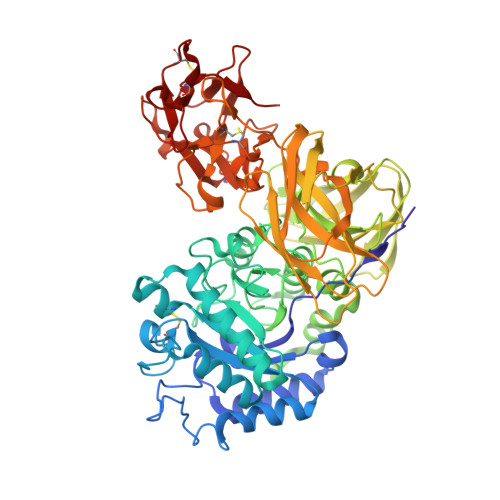A beta-l-Arabinopyranosidase from Streptomyces avermitilis is a novel member of glycoside hydrolase family 27.
Ichinose, H., Fujimoto, Z., Honda, M., Harazono, K., Nishimoto, Y., Uzura, A., Kaneko, S.(2009) J Biological Chem 284: 25097-25106
- PubMed: 19608743
- DOI: https://doi.org/10.1074/jbc.M109.022723
- Primary Citation of Related Structures:
3A21, 3A22, 3A23 - PubMed Abstract:
Arabinogalactan proteins (AGPs) are a family of plant cell surface proteoglycans and are considered to be involved in plant growth and development. Because AGPs are very complex molecules, glycoside hydrolases capable of degrading AGPs are powerful tools for analyses of the AGPs. We previously reported such enzymes from Streptomyces avermitilis. Recently, a beta-l-arabinopyranosidase was purified from the culture supernatant of the bacterium, and its corresponding gene was identified. The primary structure of the protein revealed that the catalytic module was highly similar to that of glycoside hydrolase family 27 (GH27) alpha-d-galactosidases. The recombinant protein was successfully expressed as a secreted 64-kDa protein using a Streptomyces expression system. The specific activity toward p-nitrophenyl-beta-l-arabinopyranoside was 18 micromol of arabinose/min/mg, which was 67 times higher than that toward p- nitrophenyl-alpha-d-galactopyranoside. The enzyme could remove 0.1 and 45% l-arabinose from gum arabic or larch arabinogalactan, respectively. X-ray crystallographic analysis reveals that the protein had a GH27 catalytic domain, an antiparallel beta-domain containing Greek key motifs, another antiparallel beta-domain forming a jellyroll structure, and a carbohydrate-binding module family 13 domain. Comparison of the structure of this protein with that of alpha-d-galactosidase showed a single amino acid substitution (aspartic acid to glutamic acid) in the catalytic pocket of beta-l-arabinopyranosidase, and a space for the hydroxymethyl group on the C-5 carbon of d-galactose bound to alpha-galactosidase was changed in beta-l-arabinopyranosidase. Mutagenesis study revealed that the residue is critical for modulating the enzyme activity. This is the first report in which beta-l-arabinopyranosidase is classified as a new member of the GH27 family.
- Food Biotechnology Division, National Food Research Institute, 2-1-12 Kannondai, Tsukuba, Ibaraki 305-8642, Japan.
Organizational Affiliation:





















